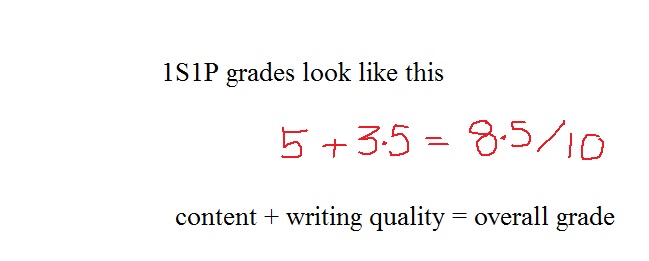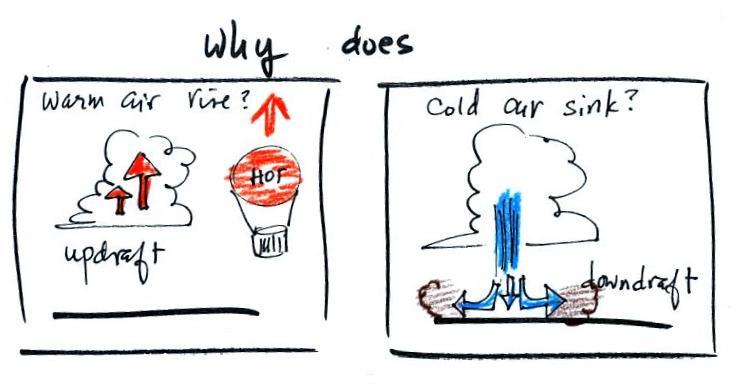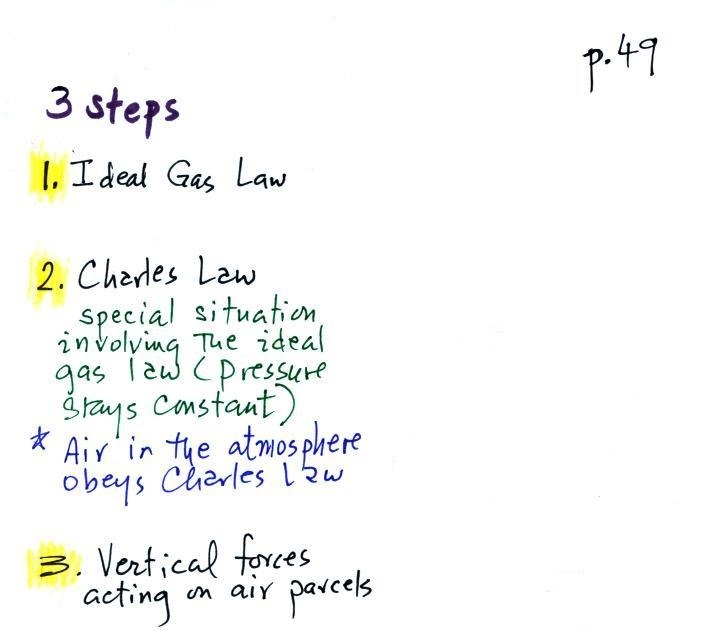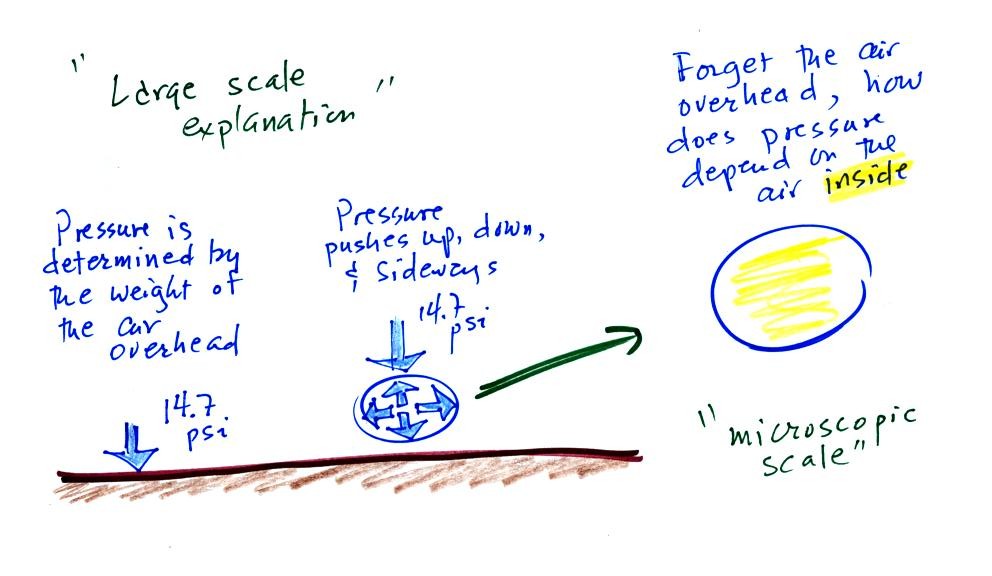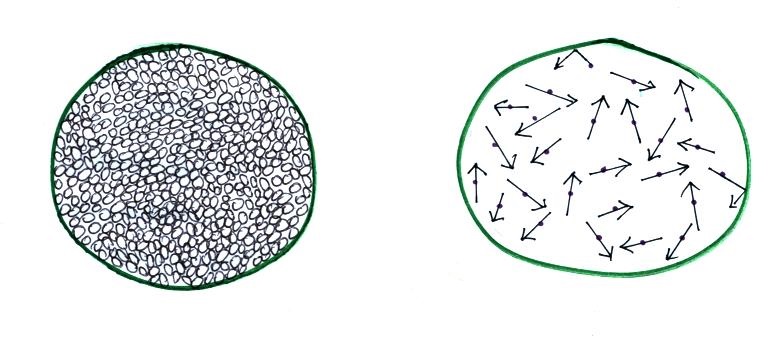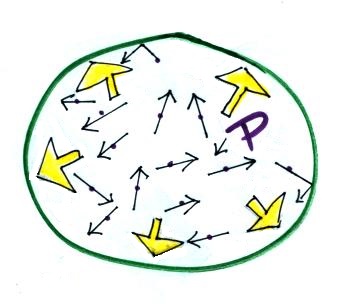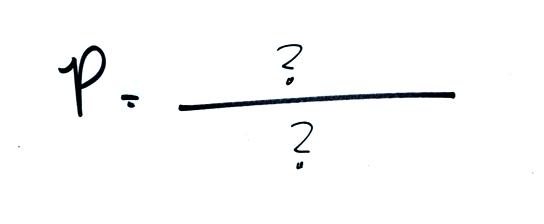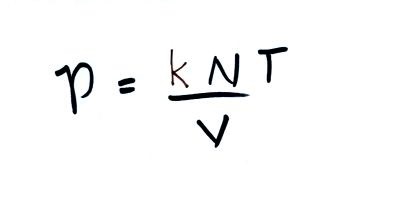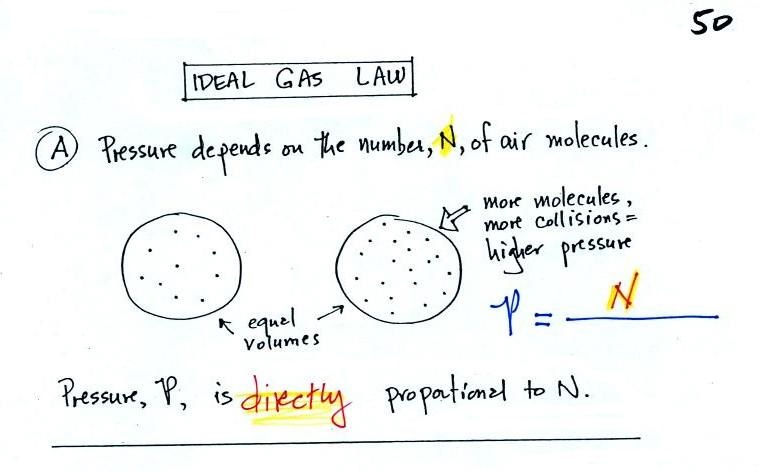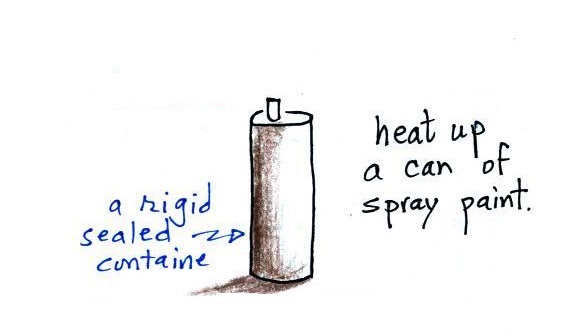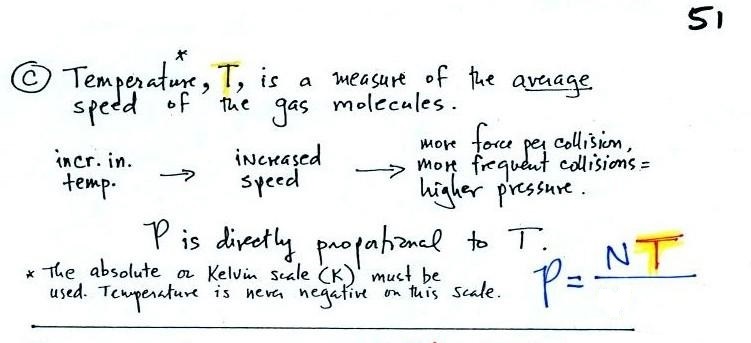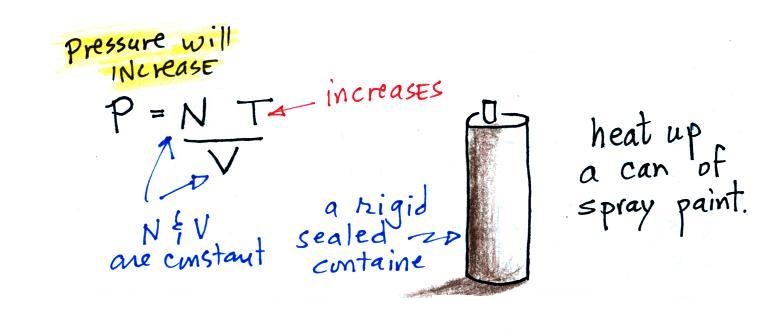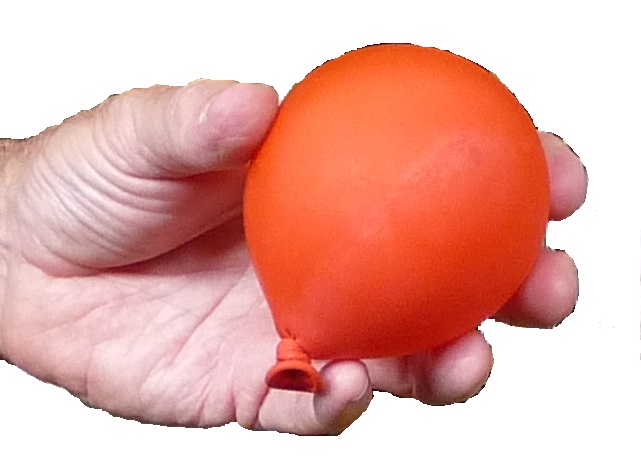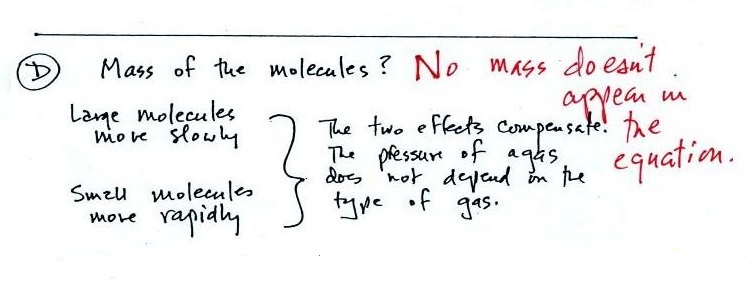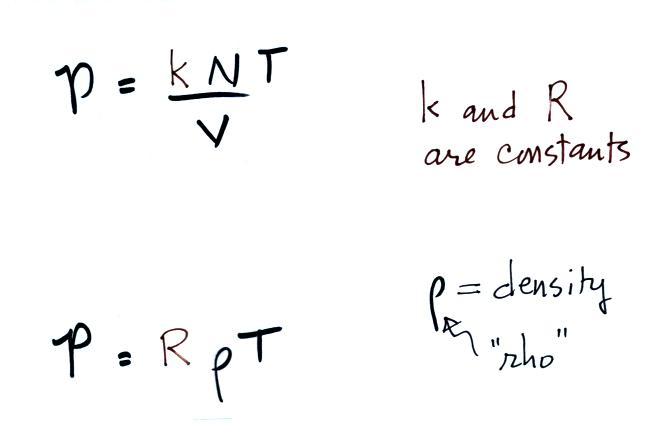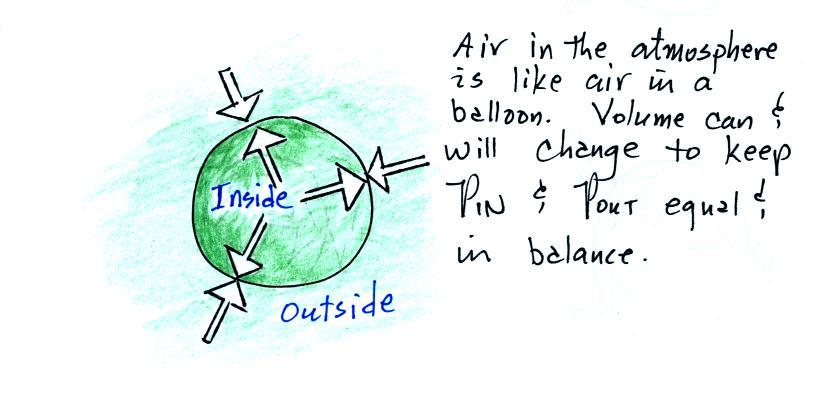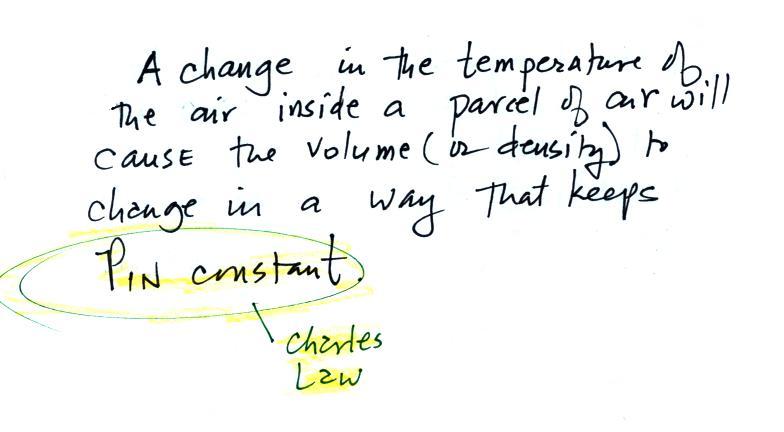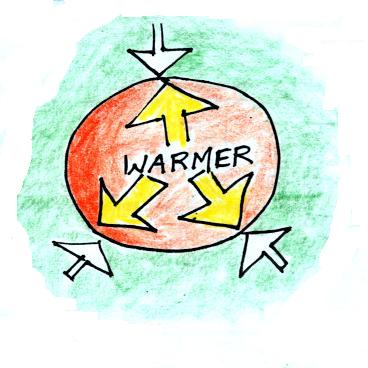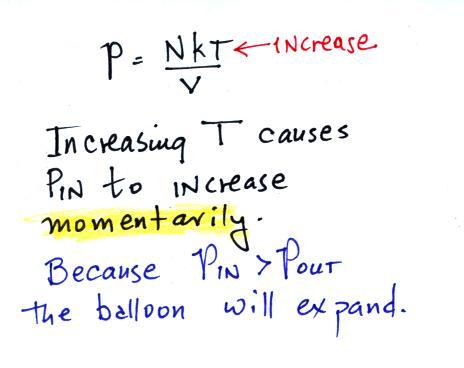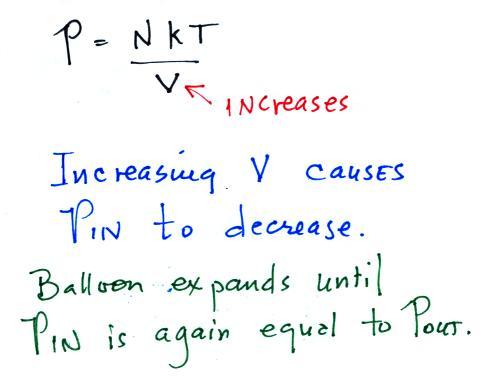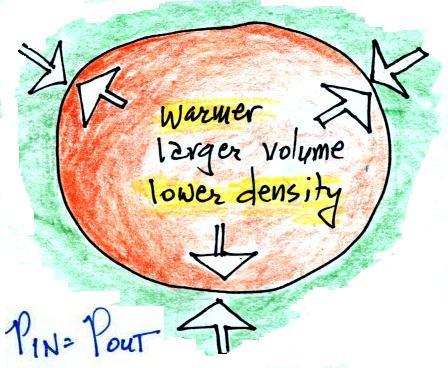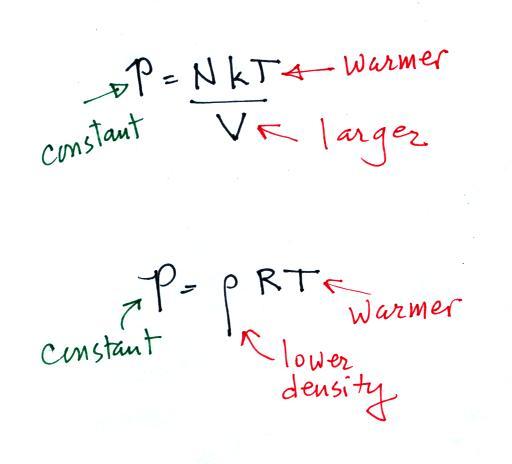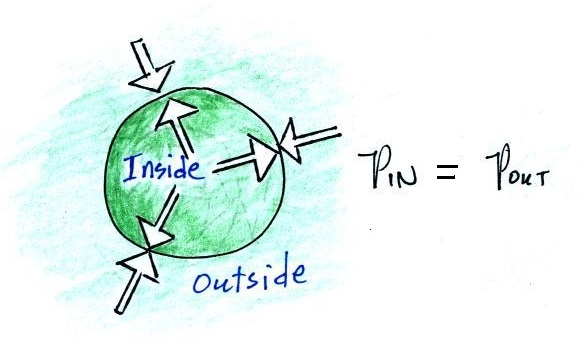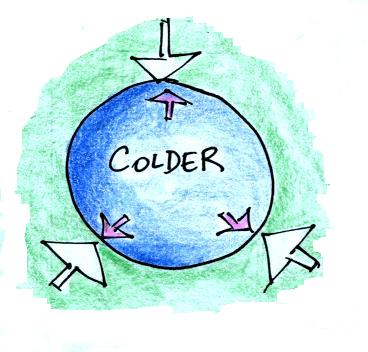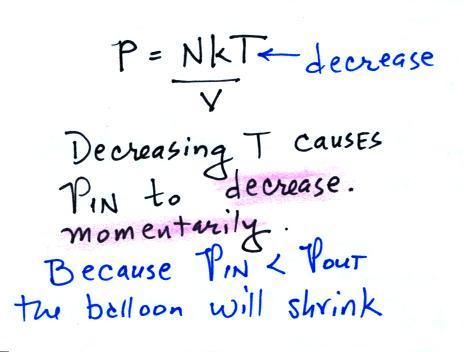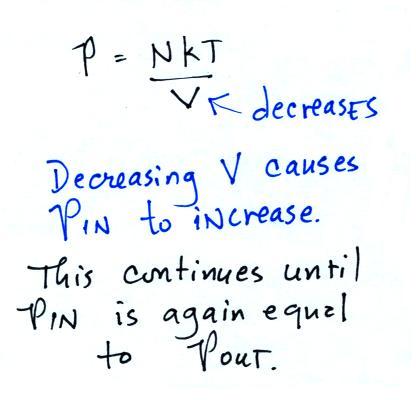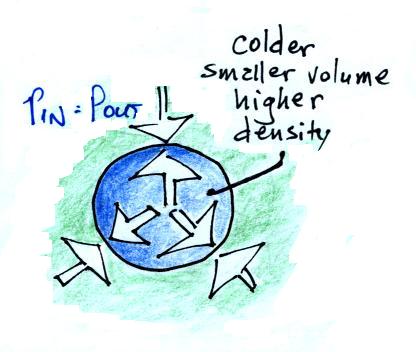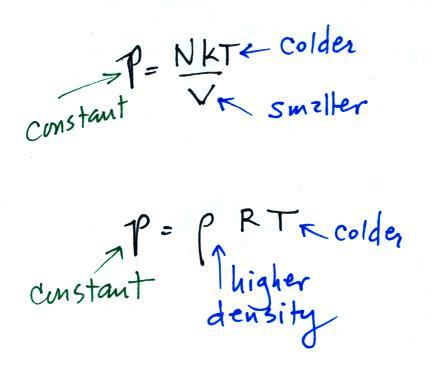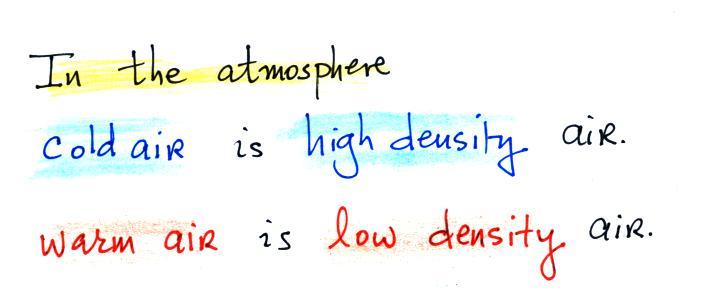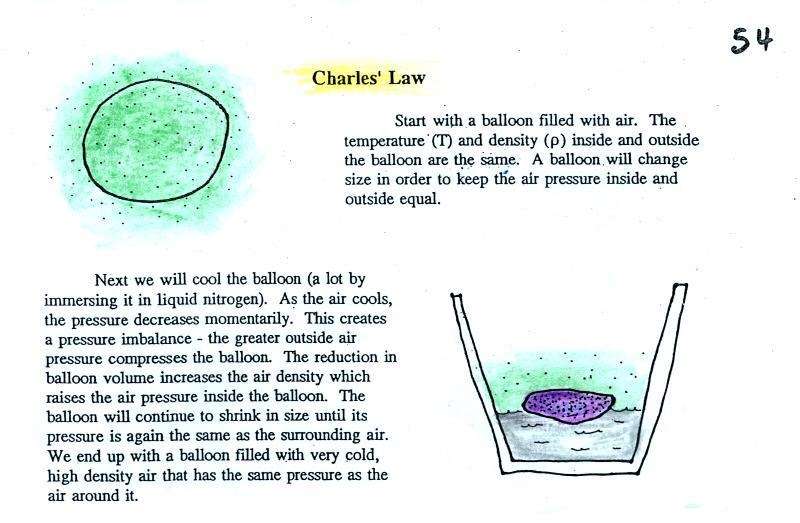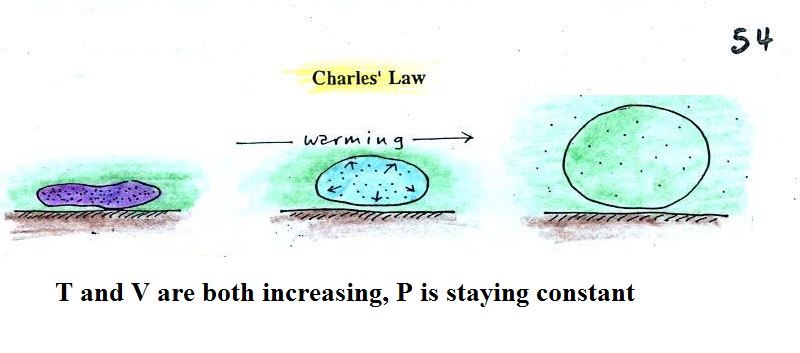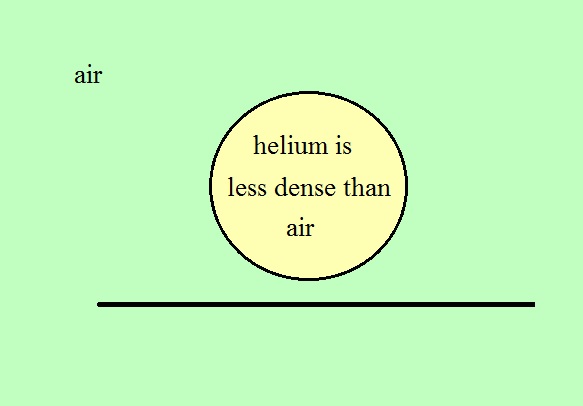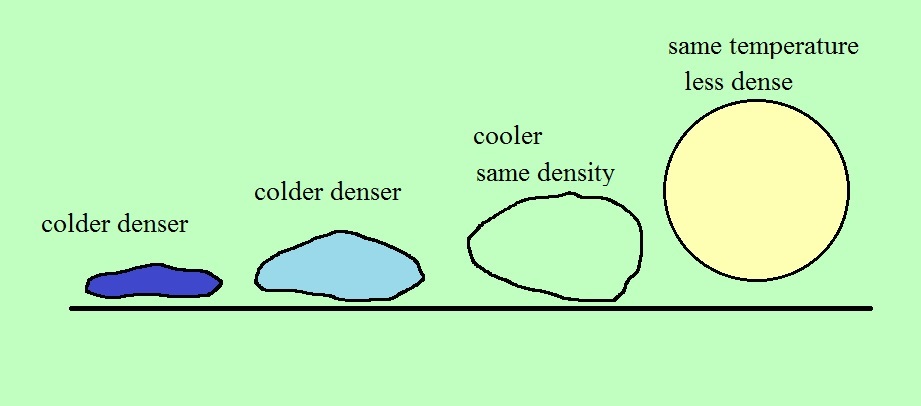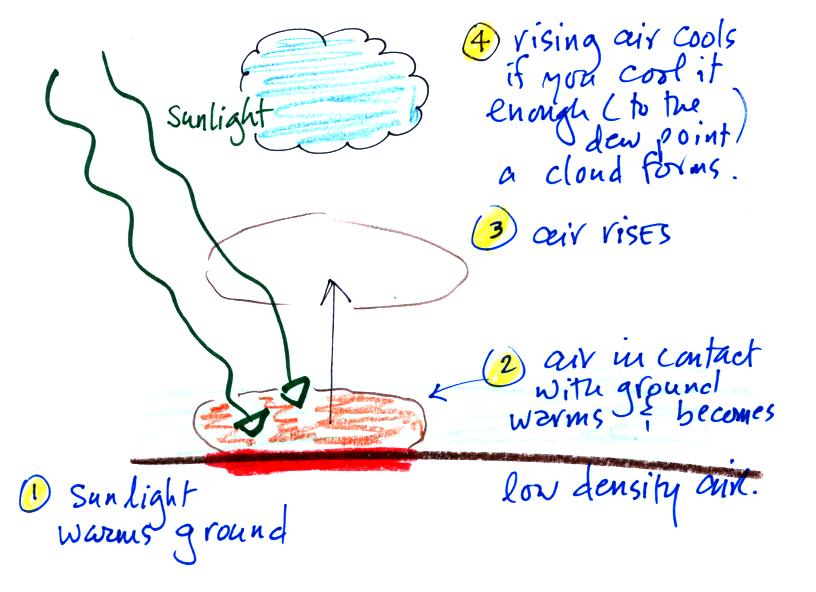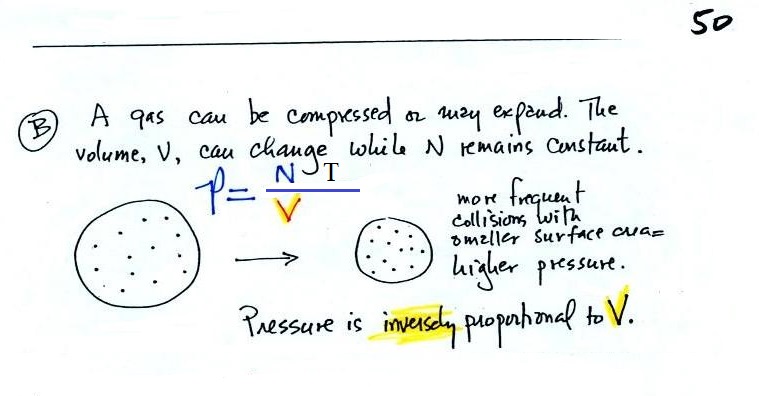
A decrease in
volume causes an increase in pressure, that's an
inverse proportionality.
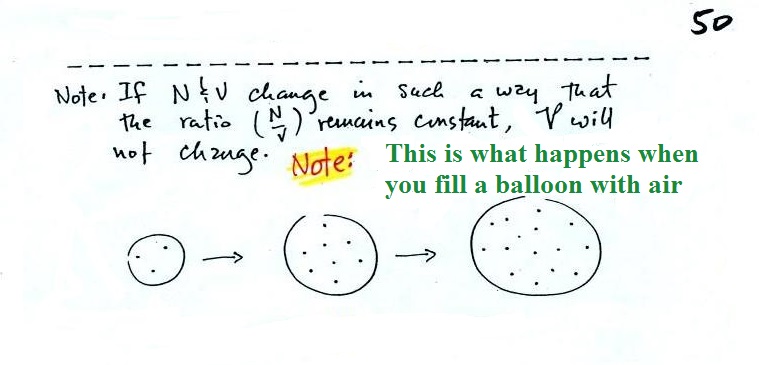
It might take three or four
breaths of air to fill a balloon. Think about
that. You add some air (N increases) and the
balloon starts to inflate (V increases). Then
you add another breath of air. N increases some
more and the balloon gets a little bigger, V has
increased again. As you fill a balloon N and V
are both increasing. What is happening in this
case is that the pressure of the air in the balloon is
staying constant. The pressure
inside the balloon pushing outward and trying to
expand the balloon is
staying equal to (in balance with) the pressure of the air
outside pushing inward and trying to compress the balloon.
Here's the same picture again except N
and V are decreasing together in a way that keeps pressure
constant. This is exactly what is happening in
Experiment #1.
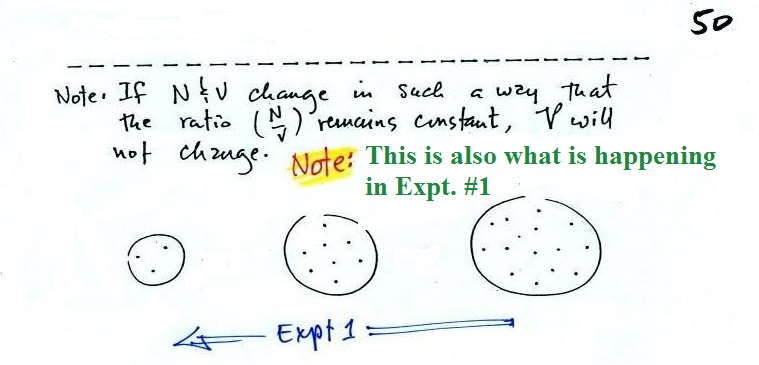
Here's a little
more detailed explanation of Expt. #1
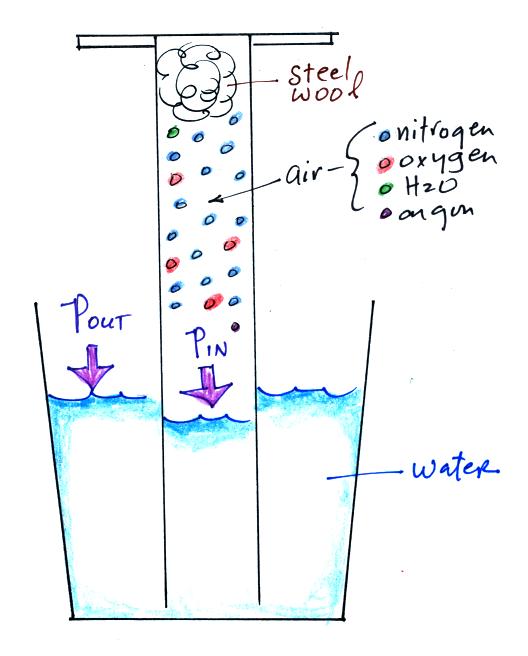
|
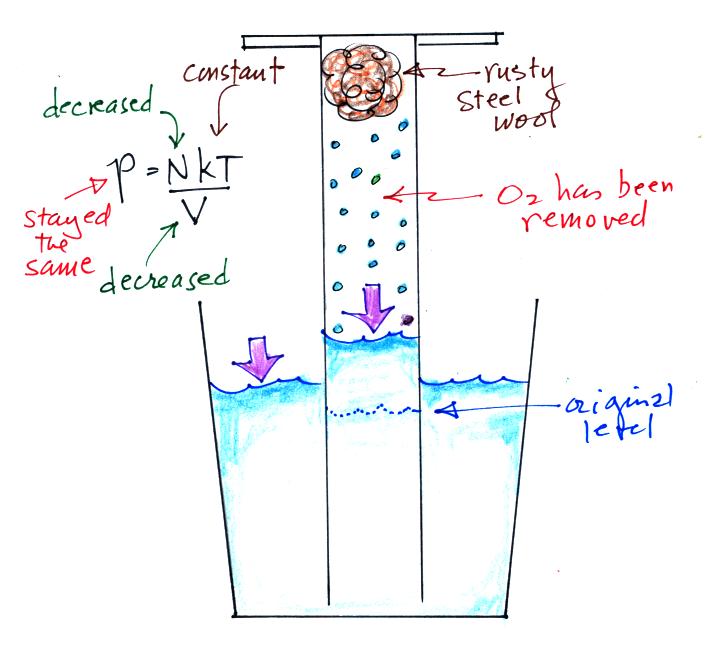
|
An
air sample is trapped together with some steel
wool inside a graduated cylinder. The
cylinder is turned upside down and the open end is
stuck into a glass of water sealing off the air
sample from the rest of the atmosphere. This
is shown at left above. The pressure of air
outside the cylinder tries to push water into the
cylinder, the pressure of the air inside keeps the
water out.
Oxygen in the cylinder reacts
with steel wool to form rust. Oxygen is
removed from the air sample which causes N (the
total number of air molecules) to decrease.
Removal of oxygen would ordinarily cause a drop in
Pin
and
upset the balance between Pin
and Pout
. But, as
oxygen is removed, water rises up into the
cylinder decreasing the air sample volume.
The decrease in V is what keeps Pin
equal to Pout
.
N and V both decrease together in the same
relative amounts and the air sample pressure
remains constant.
If you were to remove 20% of the air molecules, V would
decrease to 20% of its original value and pressure would
stay constant. It is the change in V that you can
see, measure, and use to determine the oxygen percentage
concentration in air. You should try to explain this
in your experiment report.
Here's something I didn't mention
in class. You might think that the
mass of the gas molecules inside a balloon might affect
the pressure (big atoms or molecules might hit the walls
of the balloon harder and cause higher pressure and vice
versa).
The mass of the air molecules doesn't matter. The
big ones move relatively slowly, the smaller ones more
quickly. They both hit the walls of the balloon with
the same force. A variable for mass
doesn't appear in the ideal gas law equation.
The figure below shows two forms of the
ideal gas law. The top equation is the one we've
been looking at and the bottom is a second slightly
different version. You can ignore the
constants k and R if you are just trying to understand how
a change in one of the variables would affect the
pressure. You only need the constants when you are
doing a calculation involving numbers and units (which we
won't be doing).
The ratio N/V is similar to density
(mass/volume). That's where the ρ
(density) term in the second equation comes from.
Step #2 Charles Law
Charles Law requires that the pressure of a parcel of
air remain constant (parcel is just another word for
volume). Changing the temperature of a volume of air
will cause a change in density and volume; pressure will
stay constant. This is an important situation
because this is how volumes of air in the atmosphere
behave.
This is probably the most difficult part of today's class
and is worked out in lots of detail.
We start with a balloon of air. The air
inside and outside the balloon (or parcel) are exactly the
same.
Note the pressure pushing inward is balanced by the
pressure of the air inside the balloon that is pushing
outward. If we change something inside the balloon
that upsets this pressure balance, the balloon would
expand or shrink until the pressures are again in balance.
Volumes of air in the atmosphere will always try to
keep the pressure of the air inside the parcel constant (P
inside is always trying to stay equal to P outside).
That's why we say air in the atmosphere obeys Charles'
Law.
First let's imagine warming the air inside a
balloon. We'll won't change the temperature of the
air outside the balloon.
Increasing the temperature will momentarily increase
the pressure. This creates an imbalance. Now
that P inside is greater than P outside the balloon will
expand.
Increasing the volume causes the pressure to start to
decrease. The balloon will keep expanding until P
inside is back in balance with P outside.
We're left with a balloon that is larger, warmer, and
filled with lower density air than it was
originally.
The pressures inside and outside are again the
same. The pressure inside is back to what it was
before we warmed the air in the balloon. You can
increase the temperature and volume of a parcel together
in a way that keeps pressure constant (which is what
Charles' law requires). This is equivalent to
increasing the temperature and decreasing the density
together and keeping the pressure constant.
In nature the change in temperature and volume occur
simultaneously. It's like jumping from the first to
the last step above.
We can go through the same kind of reasoning and see what
happens if we cool the air in a parcel. Actually you
should see if you can figure it yourself. I've
included all the steps below; that
wasn't done in class.
We'll start with a parcel of air that has the same
temperature and density as the air around it.
We'll cool the air inside the parcel. The air
outside stays the same.
Reducing the air temperature causes the pressure of the
air inside the balloon to momentarily decrease.
Because the outside air pressure is greater than the
pressure inside the balloon the parcel is compressed.
The balloon will get smaller and smaller (and the
pressure inside will get bigger and bigger) until the
pressures inside and outside the balloon are again
equal. The pressure inside is back to the value it
had before you cooled the air in the parcel.
The first and last steps, without all the intermediate
and momentary details, are shown below.
Cooling some air will cause volume to decrease and
density to increase while pressure stays constant.
If you want to skip all the details and just remember
one thing, here's what I'd recommend
Demonstration of Charles Law in action
Parcels of atmospheric air and air in balloons behave
the same way, they both obey Charles' Law. Charles
Law can be demonstrated by dipping a balloon in liquid
nitrogen. You'll find an explanation on the top of
p. 54 in the photocopied ClassNotes.
A balloon shrinks down to practically zero volume when
dunked in the liquid nitrogen. When pulled from the
liquid nitrogen the balloon is filled with very cold, very
high density air.
Then the balloon starts to warm up.
The volume and temperature both increasing together in
a way that kept pressure constant (pressure inside the
balloon is staying equal to the air pressure outside the
balloon). Eventually the balloon ends up back at
room temperature (unless it pops while warming up).
Step #3 Two vertical forces acting on a parcel
of air in the atmosphere
(see p. 53 in the ClassNotes)
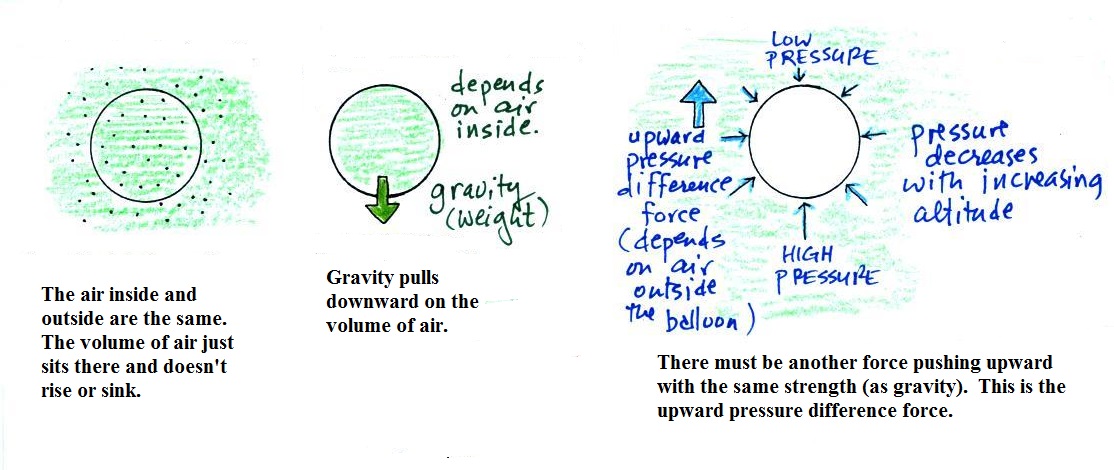
Basically it comes down to this -
there are two forces acting on a parcel of air in the
atmosphere. They are shown above.
The first force is gravity, it pulls
downward. Most everyone knows about this
force. The strength of the gravity force (the
weight of the air in the parcel) depends on the mass
of the air inside
the parcel.
Second there is an upward pointing pressure
difference force. Not too many people know about
this one. This force is caused by the air outside
(surrounding) the parcel. Pressure decreases
with increasing altitude. The pressure of the
air at the bottom of a parcel pushing upward is
slightly stronger than the pressure of the air at the
top of the balloon that is pushing downward. The
overall effect is an upward pointing force.
When the air inside a parcel is exactly the same as
the air outside (same densities), the two forces are
equal in strength and cancel out. The parcel is
neutrally buoyant and it wouldn't rise or sink, it
would just hover.
We'll replace the air inside the
balloon with either warm low density air or cold high
density air.

In the first case, a balloon with warm low density air
won't weigh as much. The gravity force is
weaker. The upward pressure difference force
doesn't change (because it is determined by the air
outside the balloon which hasn't changed) and ends up
stronger than the gravity force. The balloon
will rise.
Conversely if the air inside is cold high density
air, it weighs more. Gravity is stronger than
the upward pressure difference force and the balloon
sinks.
It all comes down to how the density of the air
in a parcel compares to the density of the air
surrounding the parcel. If the parcel is
filled with low density air it will rise. A
parcel full of high density air will sink.
That's true of things other than air. Wood
floats in water because it is less dense than water.
We're going to cover Archimedes' Law in class on
Thursday. It pretty much comes to the same
conclusion.
Here's a short demonstration of
the role that density plays in determining whether a
balloon will rise or sink (or hover)
Convection
demonstration
We used balloons filled with
helium (see bottom of p. 54 in the photocopied
Class Notes). Helium is less dense than
air even when it has the same temperature as the
surrounding air. The downward gravity
force (weight of the helium filled balloon) is
weaker than the upward pressure difference
force. You don't need to warm a
helium-filled balloon to make it rise.
We dunk the helium filled
balloon in liquid nitrogen to cool it off. When
you pull the balloon out of the liquid nitrogen it has
shrunk. The helium is denser than the
surrounding air. I set it on the table (dark
blue above) and it just sat there.
As the balloon of helium warms and expands its density
decreases (light blue). For a brief moment it
has the same density as the surrounding air
(green). It's neutrally buoyant at this
point. Then it warms back to near room
temperature where it is again less dense than the air
and lifts off the table (yellow).
Free convection
Something like this happens in the
atmosphere.
Sunlight shines through the atmosphere. Once it
reaches the ground at (1) it is absorbed and warms the
ground. This in turns warms air in contact with
the ground (2) As this air warms, its density
starts to decrease (pressure is staying
constant). When the density of the warm air is
low enough, small "blobs" of air separate from the air
layer at the ground and begin to rise, these are
called "thermals." (3) Rising air expands and
cools (we've haven't covered this yet and it might
sound a little contradictory). If it cools
enough (to the dew point) a cloud will become visible
as shown at Point 4. This whole process is
called convection; many of our summer thunderstorms
start this way.
